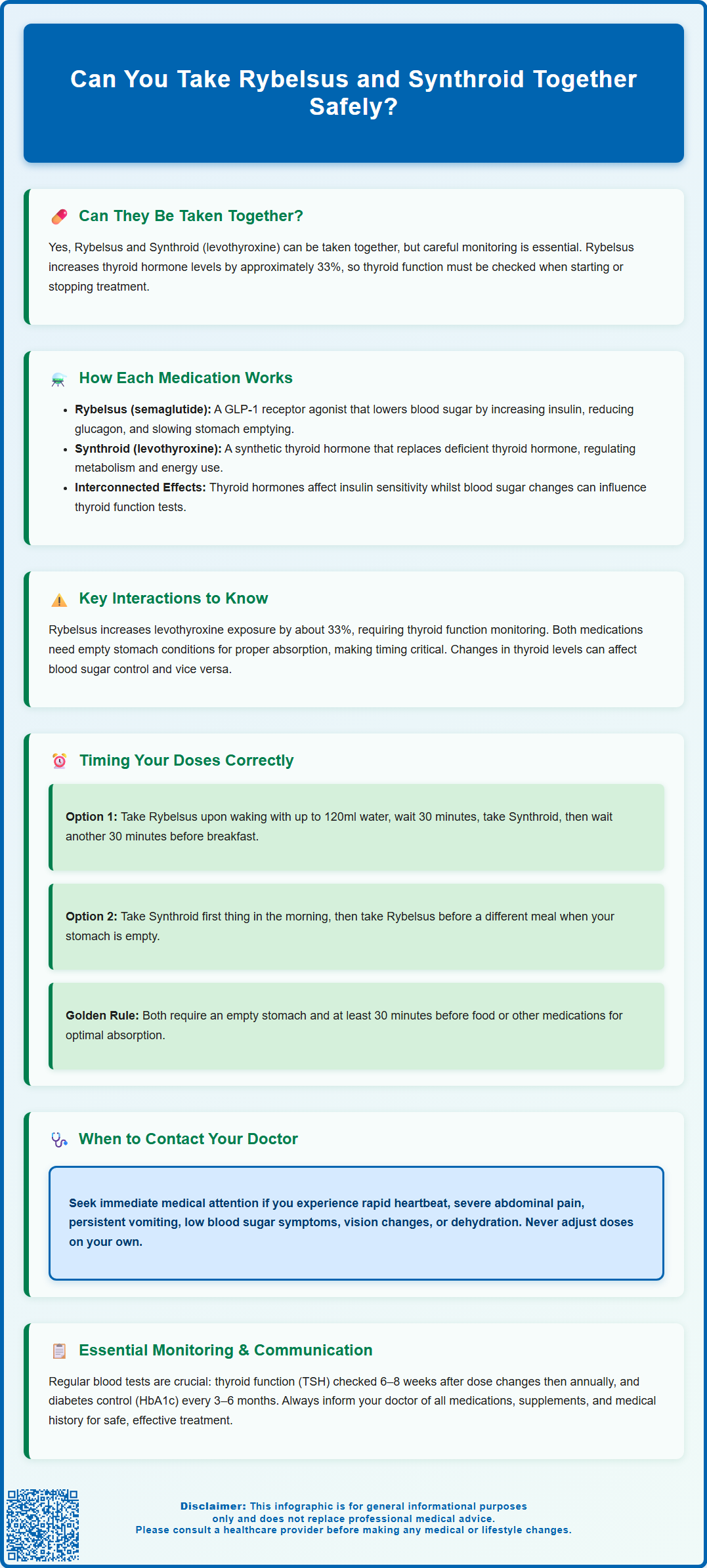Mounjaro®
Dual-agonist support that helps curb appetite, hunger, and cravings to drive substantial, sustained weight loss.
- ~22.5% average body weight loss
- Significant weight reduction
- Improves blood sugar levels
- Clinically proven weight loss

Can you take Rybelsus and Synthroid together? Many patients with type 2 diabetes and hypothyroidism require both medications concurrently. Rybelsus (semaglutide) and levothyroxine (the generic form of Synthroid) can generally be taken together, but careful attention to timing and monitoring is essential. Rybelsus increases total thyroxine exposure by approximately 33%, necessitating thyroid function monitoring when starting or stopping treatment. Both medications require administration on an empty stomach, making dosing schedules a critical consideration. Understanding the documented interaction, optimal timing strategies, and monitoring requirements ensures safe, effective concurrent use under medical supervision.
Summary: Rybelsus and levothyroxine can generally be taken together, but Rybelsus increases thyroxine exposure by approximately 33%, requiring thyroid function monitoring and careful attention to dosing timing.
Yes, Rybelsus (semaglutide) and levothyroxine can generally be taken together, but careful attention to timing and monitoring is essential. Many patients with type 2 diabetes also have hypothyroidism, making concurrent use of these medications relatively common in clinical practice.
However, there is an important interaction to be aware of: Rybelsus can increase total thyroxine (T4) exposure by approximately 33% according to the UK product information. This means that thyroid function monitoring is recommended when starting or stopping Rybelsus in patients already taking levothyroxine.
Both medications have specific absorption requirements that necessitate careful consideration of dosing schedules. Levothyroxine must be taken on an empty stomach for optimal absorption, whilst Rybelsus also requires administration in a fasting state with minimal water. These overlapping requirements mean that timing becomes a critical factor in ensuring both medicines work effectively.
The primary concerns when combining these medications relate to the documented pharmacokinetic interaction and potential absorption interference. Taking them simultaneously or too close together may compromise the absorption of one or both medicines, potentially reducing their therapeutic effectiveness. Additionally, changes in thyroid hormone levels can affect blood glucose control, and vice versa, meaning that starting or adjusting either medication may require monitoring and dose adjustments of the other.
It is essential to inform your GP or endocrinologist if you are taking both medications so they can provide specific guidance on timing, monitor your thyroid function tests and HbA1c levels appropriately, and adjust doses as needed. Never start, stop, or change the timing of either medication without consulting your healthcare professional, as this could affect your diabetes management or thyroid hormone replacement therapy.

Rybelsus (semaglutide) is a glucagon-like peptide-1 (GLP-1) receptor agonist used to improve glycaemic control in adults with type 2 diabetes mellitus. It works by mimicking the action of the naturally occurring hormone GLP-1, which is released from the intestine in response to food intake. Semaglutide enhances glucose-dependent insulin secretion from pancreatic beta cells, suppresses inappropriately elevated glucagon secretion, and slows gastric emptying. These combined mechanisms help to lower blood glucose levels, particularly after meals. Additionally, Rybelsus often leads to weight reduction, which can further improve metabolic control. The medication is taken orally once daily.
Levothyroxine sodium is a synthetic form of thyroxine (T4), the primary hormone produced by the thyroid gland. It is used as replacement therapy in patients with hypothyroidism, a condition where the thyroid gland does not produce sufficient thyroid hormone. Once absorbed, levothyroxine is converted in peripheral tissues to triiodothyronine (T3), the more active thyroid hormone. Thyroid hormones regulate numerous metabolic processes throughout the body, including energy expenditure, protein synthesis, and the metabolism of carbohydrates, fats, and proteins. They are essential for normal growth, development, and cellular function.
Both medications influence metabolism, though through entirely different mechanisms. Thyroid hormones have broad metabolic effects and can influence insulin sensitivity and glucose metabolism. Conversely, significant changes in glycaemic control or body weight (as may occur with Rybelsus) can sometimes affect thyroid function test results. Understanding these distinct but interconnected metabolic pathways helps explain why patients taking both medications require careful monitoring and individualised dose adjustments.
There is a documented pharmacokinetic interaction between Rybelsus and levothyroxine. According to the UK Summary of Product Characteristics (SmPC), co-administration of oral semaglutide with levothyroxine increases total thyroxine (T4) exposure by approximately 33%. This interaction is important to be aware of, although TSH levels typically remain unchanged.
The UK SmPC specifically recommends monitoring thyroid function when starting or stopping Rybelsus in patients who are taking levothyroxine. This allows for appropriate dose adjustments if needed.
Another consideration with concurrent use relates to absorption interference. Both medications have stringent requirements for optimal absorption. Levothyroxine absorption occurs primarily in the small intestine and can be significantly reduced by food, certain medications, and supplements. Similarly, Rybelsus has relatively low oral bioavailability and requires very specific conditions for absorption: it must be taken with no more than 120ml of water, on an empty stomach, with no food, drink, or other oral medications for at least 30 minutes afterwards.
Gastric emptying effects represent another consideration. Rybelsus slows gastric emptying as part of its mechanism of action, which theoretically could affect the absorption rate of other orally administered medications, including levothyroxine. However, clinical evidence suggests this effect is generally modest for most medications when appropriate timing intervals are observed.
Metabolic interactions may also occur indirectly. Changes in thyroid status can affect insulin sensitivity and glucose metabolism. If levothyroxine doses are adjusted, this may necessitate changes to diabetes medications, including Rybelsus. Conversely, significant weight loss achieved with Rybelsus may occasionally affect thyroid hormone requirements, though thyroid function tests should guide any dose adjustments rather than weight changes alone. Regular monitoring of both thyroid function (TSH, free T4) and glycaemic control (HbA1c, fasting glucose) is therefore recommended when taking both medications, particularly when initiating therapy or adjusting doses.
Proper timing is crucial to ensure both Rybelsus and levothyroxine are absorbed effectively and work as intended. According to UK product information, the key requirement is that Rybelsus should be taken on an empty stomach with up to 120ml of water, followed by at least 30 minutes before consuming any food, beverages (other than water), or other oral medications (including levothyroxine).
Levothyroxine should typically be taken on an empty stomach, at least 30 minutes before breakfast, with a full glass of water. This allows for optimal absorption before food interferes with uptake. Many patients take levothyroxine first thing upon waking, then wait before eating breakfast. Consistency in timing is important for maintaining stable thyroid hormone levels.
A practical approach for many patients is:
Take Rybelsus first thing upon waking with up to 120ml of water
Wait at least 30 minutes
Take levothyroxine with water
Wait another 30 minutes before eating breakfast
Alternatively, some patients may find it easier to take levothyroxine first thing in the morning and Rybelsus before another meal when the stomach is empty, ensuring the 30-minute minimum waiting period after Rybelsus before taking any other oral medications, food or drink.
It's worth noting that while the minimum waiting time after Rybelsus is 30 minutes, absorption may increase with longer intervals (up to 60 minutes) if this is practical for your routine.
Discuss the most practical schedule with your GP or pharmacist, as individual circumstances, work schedules, and other medications will influence the optimal timing strategy. Once established, maintain consistency in your routine, as this helps ensure stable medication levels and optimal therapeutic effects. If you need to change your dosing schedule, consult your healthcare professional, as this may require additional thyroid function monitoring.
Before starting or combining Rybelsus and levothyroxine, provide your doctor with a complete medical history to ensure safe and effective treatment. This comprehensive discussion helps identify potential concerns and allows for appropriate monitoring and dose adjustments.
Inform your doctor about:
All current medications, including prescription medicines, over-the-counter drugs, vitamins, and herbal supplements. Certain medications can affect thyroid hormone absorption (such as calcium, iron, proton pump inhibitors) or interact with diabetes medications
Complete medical history, particularly any history of thyroid disorders, pancreatitis, diabetic retinopathy, kidney disease, or gastrointestinal conditions
Pregnancy plans or current pregnancy. Rybelsus should be discontinued at least 2 months before a planned pregnancy and is not recommended during pregnancy or breastfeeding. Levothyroxine requirements often increase during pregnancy
Previous adverse reactions to any medications, particularly GLP-1 receptor agonists or thyroid preparations
Discuss your current control and symptoms:
Recent thyroid function test results (TSH, free T4) and symptoms of hypothyroidism or hyperthyroidism
Current glycaemic control (HbA1c levels) and any episodes of hypoglycaemia
Any gastrointestinal symptoms, as Rybelsus commonly causes nausea, vomiting, and diarrhoea, particularly when starting treatment
Establish a monitoring plan with your healthcare team. You will likely need regular blood tests to monitor thyroid function (typically TSH checked 6–8 weeks after any dose change, then annually once stable) and diabetes control (HbA1c every 3–6 months). Your doctor should also assess for potential adverse effects of both medications.
Contact your GP promptly if you experience:
Symptoms of hyperthyroidism (rapid heartbeat, tremor, anxiety, weight loss) or worsening hypothyroidism symptoms (fatigue, weight gain, cold intolerance)
Severe or persistent gastrointestinal symptoms
Signs of hypoglycaemia, particularly if taking other diabetes medications such as sulfonylureas or insulin (which may require dose reduction when starting Rybelsus)
Severe abdominal pain (potential pancreatitis)
Visual changes (potential diabetic retinopathy progression)
Dehydration due to gastrointestinal side effects, which could affect kidney function
Never adjust doses of either medication independently. Both require careful titration and monitoring under medical supervision to achieve optimal therapeutic effects whilst minimising adverse effects.
If you experience any suspected side effects from either medication, you can report them via the MHRA Yellow Card scheme at yellowcard.mhra.gov.uk or through the Yellow Card app.
Take Rybelsus first with up to 120ml of water, wait at least 30 minutes, then take levothyroxine. Wait another 30 minutes before eating breakfast to ensure optimal absorption of both medications.
Rybelsus increases thyroxine exposure by approximately 33%, so your GP should monitor thyroid function tests when starting or stopping Rybelsus and may adjust your levothyroxine dose accordingly.
Regular monitoring should include thyroid function tests (TSH, free T4) typically 6–8 weeks after dose changes, and diabetes control measures (HbA1c) every 3–6 months, along with monitoring for symptoms of thyroid dysfunction or medication side effects.
The health-related content published on this site is based on credible scientific sources and is periodically reviewed to ensure accuracy and relevance. Although we aim to reflect the most current medical knowledge, the material is meant for general education and awareness only.
The information on this site is not a substitute for professional medical advice. For any health concerns, please speak with a qualified medical professional. By using this information, you acknowledge responsibility for any decisions made and understand we are not liable for any consequences that may result.
Lorem ipsum dolor sit amet, consectetur adipiscing elit, sed do eiusmod tempor incididunt ut labore et dolore magna aliqua. Ut enim ad minim veniam, quis nostrud exercitation ullamco laboris nisi ut aliquip ex ea commodo consequat. Duis aute irure dolor in reprehenderit in voluptate velit esse cillum dolore eu fugiat nulla pariatur.
Block quote
Ordered list
Unordered list
Bold text
Emphasis
Superscript
Subscript